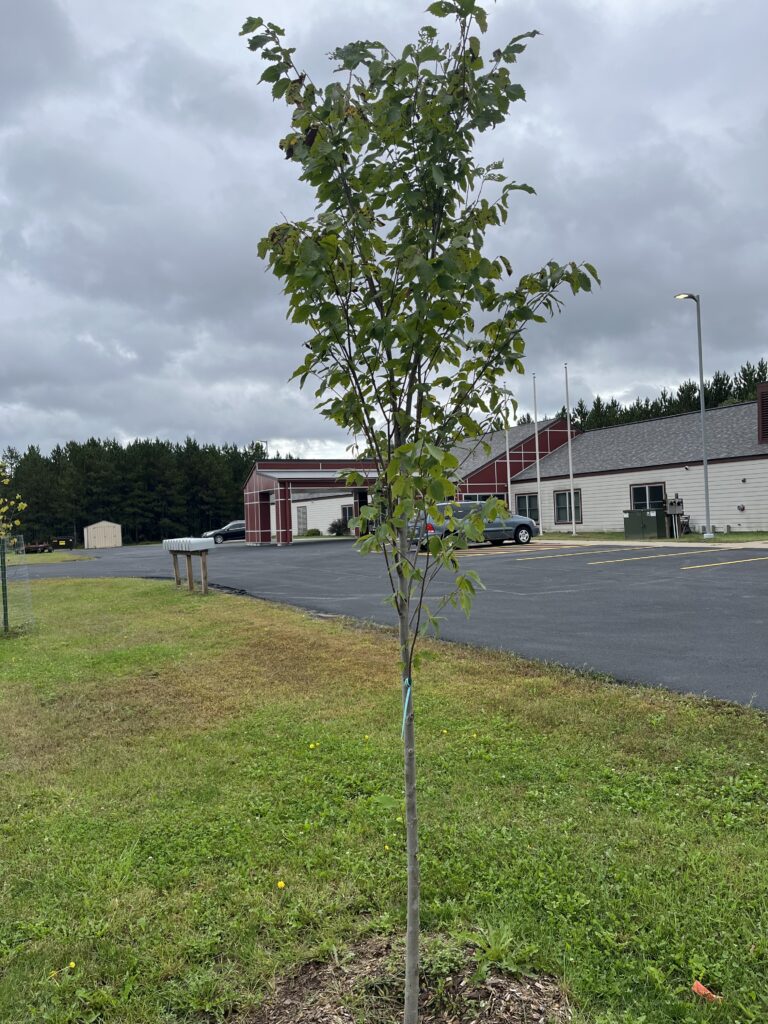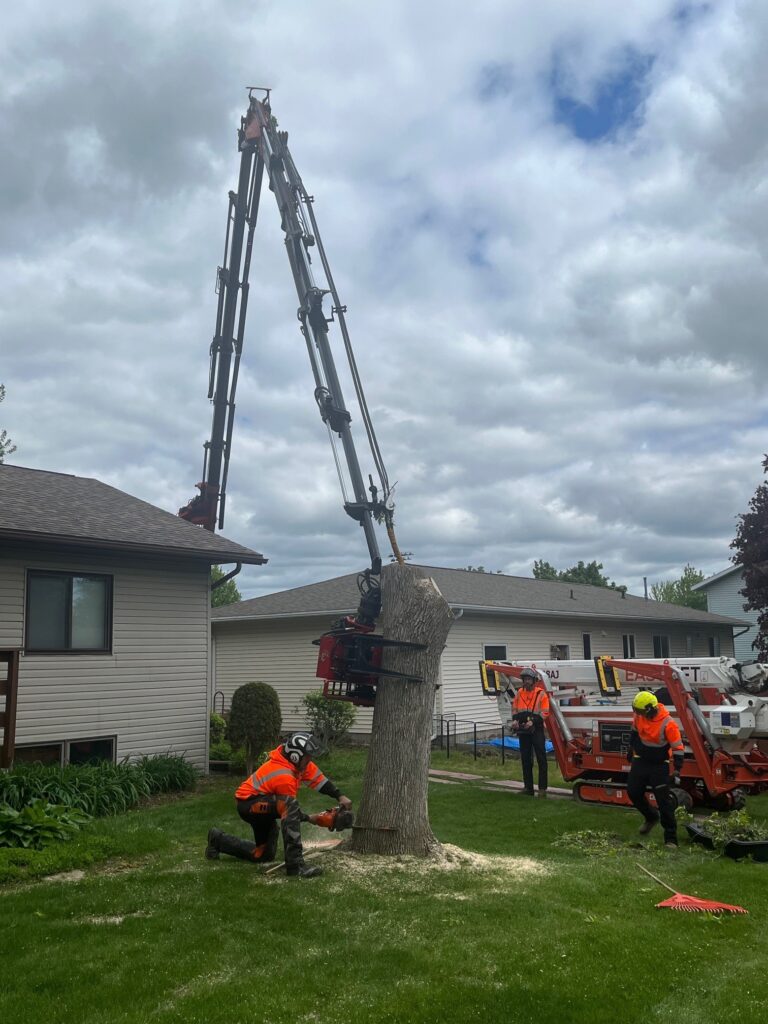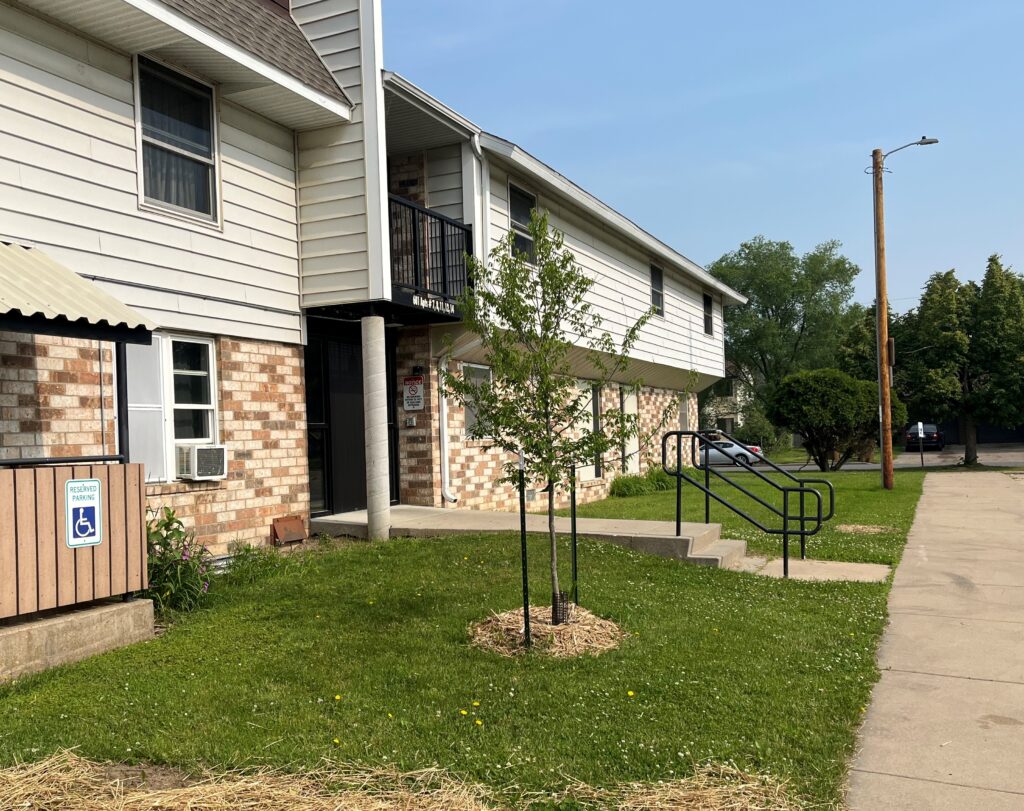By Jay Dampier, DNR IRA Grant Coordinator, Jason.Dampier@wisconsin.gov or 920-765-1935

A tree planted with IRA funds is poised to provide shade over the parking lot at Mᶏᶏnᶏᶏpe Hocira – Ho-Chunk Veterans Housing Complex.
On a crisp spring morning in 2025, shovels break ground along a city street in Wisconsin. In another community, trees are being inventoried and assessed for risk. Elsewhere, a dangerous dead ash tree is being removed with a crane to make a neighborhood safer. It’s all part of a bold, three-year initiative made possible through the Inflation Reduction Act (IRA) and administered by the DNR’s Urban and Community Forestry Program. One year in, the thirteen grant-funded projects totaling $4 million are already taking root. Grantees include municipalities, tribes, nonprofits and one county. Grant awards range from under $100,000 to nearly $500,000 and are helping communities grow healthier, greener and more resilient. Together, these efforts are transforming neighborhoods and creating a legacy of shade, clean air and beautification across Wisconsin.
So far, accomplishments include:
- 5,723 trees inventoried (including trees, stumps and potential planting sites)
- 760 trees maintained (including trees that have been pruned, removed or stump ground to prepare a new planting site)
- 652 trees planted (planted directly by grantees or through a tree giveaway)
- 112 people receiving arboriculture and urban forestry workforce development
Going beyond the numbers, communities are being transformed. For example, the City of Colby is already seeing the positive impact of their IRA-funded community tree planting. Residents have responded they are “very happy” with how the newly planted trees are improving the community’s esthetics along streets and on private properties. One hundred trees have already been planted with another 100 scheduled next spring.

Tree removal by IRA funded contractor. / Photo courtesy of Marathon County
Homeowners in Marathon County and the City of Wausau are also seeing the positive impacts of their local IRA-funded initiatives. Many communities like Wausau do not typically have a program to help mitigate risk trees on private property. IRA funds are being used to remove dangerous trees from private properties within affected communities. One thankful resident who reached out to the project lead commented, “We want to thank you and your staff for securing the grant for this project, as we wouldn’t have been able to do the work being on a fixed income. We are so thankful!”
Other IRA-funded projects are providing urban forestry and arboriculture workforce development. In Madison, the nonprofit Operation Fresh Start has been using IRA funds to train young adults, providing certifications such as chainsaw safety, while providing important work experiences. One program participant remarked, “The IRA fund has given me professional opportunities to spread my wings… It’s given me more of a professional outlook to explore different careers in natural resource management.” Another program participant commented, “Since I’ve been in [the program], I feel like I’ve really grown as a person. I am meeting new people and participating in different activities and even going to therapy. It has helped me a lot. I’ve learned so much from this experience. I really enjoy the smoothness and satisfaction of using the chainsaw and cutting down trees. It’s honestly very rewarding, and I just love working with trees.”
In Milwaukee, another nonprofit is taking a different community-based approach. Milwaukee Water Commons’ IRA-funded initiatives are working to build local community capacity, which includes developing a community tree board. One community member said that their participation on the tree board has, “… been an opportunity to connect with neighbors, see the positive work happening across the city and engage more deeply in community outreach to support green infrastructure.” Another tree board member has similar sentiment, “As a member of the Tree Board, I’ve been connecting with residents to share the benefits of trees and helping coordinate next steps for community-led urban tree reforestation on Milwaukee’s north side of town.” Next steps in this project will include tree planting within the neighborhood. Another enthusiastic community partner shared, “With this project, we’re bringing beautification and so many of the benefits of trees for a healthier, more beautiful neighborhood for everyone.”
There is still much work to do as the IRA-funded projects hit their first-year milestone of this three-year initiative.

A newly planted tree brings beautification and other benefits to a residential area in Stevens Point.
2024-2027 Inflation Reduction Act (IRA) Urban Forestry Grant Recipients
- Marathon County Parks, Recreation and Forestry Department: $498,482.08, City of Wausau Tree Planting and Private Ash Mitigation Project
- Ho Chunk Nation: $497,630, Ho Chunk Urban Forest Regeneration Program
- Milwaukee Water Commons: $494,372, Branch Out Milwaukee: Metcalfe Park
- City of Eau Claire: $486,000, Greening Urban Spaces
- City of Racine: $453,450, Ash Removal/Replacement and Pruning in Parks and Bilingual Outreach in Neighborhoods
- Urban Tree Alliance: $450,062, Neighborhood Forest Project
- Operation Fresh Start: $388,834, Urban Forestry Empowerment Initiative
- Bad River Band of Lake Superior Tribe of Chippewa Indians: $188,722.23, Bad River Greenspace Improvement Project
- City of Rhinelander: $182,000, Rhinelander Urban Forest Recovery and Revitalization
- City of Sheboygan: $174,616.42, Reforestation and Retention of Trees in the City of Sheboygan to Improve Air Quality
- City of Stevens Point: $105,500, Shading and Feeding Stevens Point
- City of Colby: $47,900, To Make the City of Colby Green
- City of Schofield: $32,431.08, Tree Canopy Addition at the Community Connector Trail
Additional information for each project can be found at Urban Forestry Inflation Reduction Act Grants Webpage.
